![]()
I  RAIN
RAIN
Or
Soddenly last summer
Ars June 24-30 1997
For us, the Île de Ré was indeed the Isle of Rain—its virtues were largely negative. Its miles of beaches are not lined with condominiums, its tourist-centered villages do not contain a single familiar fast food outlet. Even the scenery is understated. A lazy cyclist’s paradise, the terrain is about as hilly as Holland. Much of it is treeless, so that after crossing its bare salt marshes a stroll through the copses which dot the periphery seems like entering the Maine woods. The buildings are uni formly low and simple, with white plaster walls and pale yellowish-orange tiled roofs. Even the traditional local pastry is deceptively austere: a tourteau-fromage artisanal which conceals inside its burned black tortoise-shell a soft moist cheesecake whose principal ingredient is a luxuriously high-fat fromage frais.
formly low and simple, with white plaster walls and pale yellowish-orange tiled roofs. Even the traditional local pastry is deceptively austere: a tourteau-fromage artisanal which conceals inside its burned black tortoise-shell a soft moist cheesecake whose principal ingredient is a luxuriously high-fat fromage frais.
In a normal summer such visual simplicity merely emphasizes the light and the water. I had anticipated a déjà vu experience of Cape Cod: artists flock to such places, not because the scenery is dramatic, but because the coastal climate varies the lighting with constantly changing misty filters. Unseasonal wintry monsoons are a different matter: on this flat barren island the unhappy holiday-maker is trapped in a dour bleakness which recalls the treeless wastes near Malin Head in Donnegal or Point Reyes north of San Francisco, but devoid of their stony sweep and grandeur. If you’ve come here to work, you can shut the doors and windows, turn on the lights and get on with it; but if you’re here for sea and sand, sun and sky, then endless sizzle-sozzle is a depressing anticlimax. It feels like a vast damp English holiday camp minus the nightly knees-up.
In such unfriendly weather there is also the psychological isolation of being trapped on an island. An impressive viaduct, almost two miles long, leads straight into La Rochelle, a busy seaport town, but the toll is a steep 110 francs. Only to the island of course; leaving it is free, although this summer there must be some who would gladly pay double that figure to depart.
AFTER a ten-day soak in Paris, Mary and I approached the Île de Ré with guarded optimism. During the five-hour drive down the A10 the rain clouds had gradually cleared so that we crossed the bridge in pale wintry sunlight. Le Parasol, one of the few Michelin-recommended Hotels de Logis on the island which do not cost a fortune, is near the far end just beyond the village of Ars on the edge of state-protected woods. Our room proved to be at the end of a row of “studios” of the motel variety—a large bedsitter, but with no comfortable place to sit. It contained two beds, a small round oilcloth-topped dining table with two wooden chairs and two stools (to fall between?), and that was it. No curtains, no pictures on the walls, no rugs for relief from the cold tile floors. Details were shabby; there was no bathroom cabinet, only a rough-cut shelf u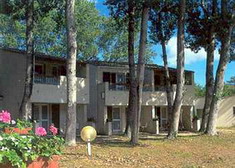 nder the wash basin. It was the sort of austerity you might expect in a college dorm. The only modest plusses were a separate bathroom and toilet and a small kitchenette for limited self-catering. A door at the far end opening onto a private patio also admitted the noise from the main road just beyond a hedge. On a sunny day, with high holiday traffic, it would have called for round-the-clock ear plugs. At 450 francs a night we’d expected a modicum of grace. How this rated Michelin “comfortable” and “quiet situation” ratings I can’t imagine. The inspector must have been a deaf mendicant friar.
nder the wash basin. It was the sort of austerity you might expect in a college dorm. The only modest plusses were a separate bathroom and toilet and a small kitchenette for limited self-catering. A door at the far end opening onto a private patio also admitted the noise from the main road just beyond a hedge. On a sunny day, with high holiday traffic, it would have called for round-the-clock ear plugs. At 450 francs a night we’d expected a modicum of grace. How this rated Michelin “comfortable” and “quiet situation” ratings I can’t imagine. The inspector must have been a deaf mendicant friar.
After dumping our bags, we set out for a walk in the late afternoon sun through a stunted mix of deciduous and evergreen trees which reminded me both of Provincetown’s “backside” and the struggling cypresses of Monterey’s Point Lobos. With soft sand underfoot and twisted branches overhead, I was trudging back down the receding corridors of early childhood. As we drew near the sea, I even began to smell the evocative pungent reek of clam flats at low tide. It grew stronger. There, just across the road at the edge of the woods—could those long shallow pools be for the evaporative extraction of sea salt, an important local industry?
Nope. It was a sewage processing plant. A scene from Eric von Stroheim’s Greed swam before my eyes, in which the loving couple share a romantic picnic on a rock by the San Francisco Bay amidst rotting fish. We turned left, then left again on a road which led back to the hotel along the edge of a sprawling trailer camp.
 PUTTING all our eggs in one omelette, I had booked us into Le Parasol for demi-pension: we would be eating all our dinners there. It was the right decision. What was lacking in our accommodation was partly compensated for in the dining room and kitchen. Most of the tables were taken up every night with solid French couples who had accumulated their corporeal substance over the years in sound bougeoise establishments such as this. We would enjoy a soupe de poisson of robustly assertive fishiness (though the rouille had been toned down for effete northern tastes). There was a flawless fresh fried whole daurade, its complex flavors unmasked by any unnecessary and irrelevant sauce. Some of the desserts were outstanding; a myrtle tart came with a lush but not too sweet fruit filling which just managed to keep its shape without the tell-tale flavor of a floury thickening agent, perched on a crisp pâte brisée which tasted positively homemade. Only an occasional lapse of taste, such as a delicate fillet of loup whose flavor was lost in a strong grain mustard sauce, suggested that the chef was perhaps more artisan than artist. Nevertheless his dishes were consistently superior to the one meal we took elsewhere at a Gault Millau-recommended restaurant.
PUTTING all our eggs in one omelette, I had booked us into Le Parasol for demi-pension: we would be eating all our dinners there. It was the right decision. What was lacking in our accommodation was partly compensated for in the dining room and kitchen. Most of the tables were taken up every night with solid French couples who had accumulated their corporeal substance over the years in sound bougeoise establishments such as this. We would enjoy a soupe de poisson of robustly assertive fishiness (though the rouille had been toned down for effete northern tastes). There was a flawless fresh fried whole daurade, its complex flavors unmasked by any unnecessary and irrelevant sauce. Some of the desserts were outstanding; a myrtle tart came with a lush but not too sweet fruit filling which just managed to keep its shape without the tell-tale flavor of a floury thickening agent, perched on a crisp pâte brisée which tasted positively homemade. Only an occasional lapse of taste, such as a delicate fillet of loup whose flavor was lost in a strong grain mustard sauce, suggested that the chef was perhaps more artisan than artist. Nevertheless his dishes were consistently superior to the one meal we took elsewhere at a Gault Millau-recommended restaurant.
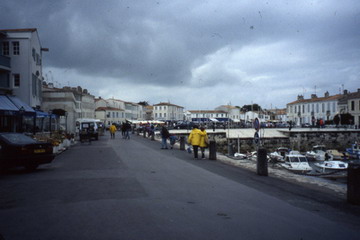 THE first morning drowned our blue-skied optimism. We awoke to a steady rain which promised to go on forever. We had planned to bike into Ars for the daily market, but we were forced back into the van, in which we drove into town along empty narrow streets past closed shutters that made us feel like the unwelcome avant-garde of an occupying army.
THE first morning drowned our blue-skied optimism. We awoke to a steady rain which promised to go on forever. We had planned to bike into Ars for the daily market, but we were forced back into the van, in which we drove into town along empty narrow streets past closed shutters that made us feel like the unwelcome avant-garde of an occupying army.
Most of the market was mercifully indoors. It held a foretaste of infinite promise. A jovial stallholder was selling a silver-medal-winning proprietary Bordeaux for nineteen francs a bottle. A man ahead of me, obviously a friend, sampled it and kissed his fingers to the sky. I tasted it and thought, I’m romanticizing—it can’t be that good at that price. Maybe this guy is hired to encourage the punters. I finally took away half-a-dozen. I’m drinking it now. Would that I had cleaned him out!
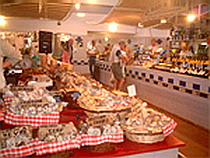
There were yards and yards (metres and metres?) of counter space filled with unfamiliar seafood, local cheeses, spanking fresh fruits and vegetables, and a cornupopia of locally cooked dishes which, if available back home, could tempt us to lock up our kitchen and throw away the key. Their tarte de fruit de mer was to die for, but by the time we’d made up our minds as to just what we wanted it had sold out. We strolled along the aisles, sampling bits of cheese, salami and paté which were thrust upon us for our consideration. Everybody knew each other, and we were obviously interlopers before we had even opened our mouths—the first wave of a summer’s profitable invasion.
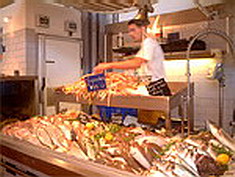
I knew already that the excellent seafood selection was due to the labors, not of local fishermen, but of lorry drivers. It no longer comes from the harbor, but across the bridge from the huge market in La Rochelle. In a large tank at the end of the counter, Crustacea of various obscure species were holding a convention. The fruit and vegetables were packed in boxes which showed that most of them had traveled even further than the fish. Where today, aside from the farmers’ markets of California, can you buy genuinely local produce? But there were radishes which made us care not a jot whether they had arrived from outer space: huge, crisp and hot. Even ten days later they haven’t wilted—the last of them are being finished by Mary even as I write. Can radishes like that be bought in London? Perhaps at Fortnum and Mason’s, in exchange for a day’s wages. And there was a bin of seriously overripe peaches at a bargain price. For a few francs I bought a couple of huge ones with dented sides, the best of the lot, and took them back to our hotel fridge. One of them was the juiciest, tastiest peach I’d ever eaten; long afterward I was still savoring the finish of a superb eau de vie.
OUTSIDE the rain was bucketing down. What to do with the rest of the day? After sloshing back to our room for a cold collation, we set out for the Phare des Baleines, a century-and-a half-old lighthouse up which one can climb 257 steps to a panoramic view of the island. In such weather, we might even have it to ourselves.
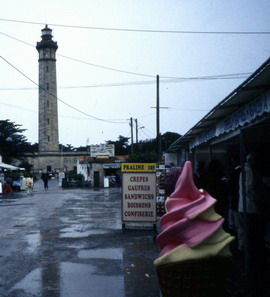
Sick joke. We arrived at a Via Appia lined with rows of empty tour buses and a receding perspective of junk food establishments and souvenir shops. No international chains here—this was world-class squalor achieved entirely with local talent. The 180-foot lighthouse was flanked by giant ice cream cones in the foreground which dwarfed it at close perspective. Crowds of sullen day-trippers skulked around the shops, exhibiting evident displeasure at having been cheated out of their rightful share of midsummer sun. As we approached the entrance to the lighthouse the last of a straggle of visitors was being admitted. Without warning we were confronted with the broad oilskinned back of a grizzled guard who, Cerberus-like, barred our entrance.
—Est-ce que possible d’entrer, monsieur? Mary asked politely.
—NON! he barked without turning either of his heads.
Next we approached a shop and asked for stamps.
—NON! encore, with a gesture across the street.
The third response was civil but unhelpful; they’d sold out. Eager to put as much space as possible between ourselves and this Stygian vista, we splashed back to the van.
TO the east from the lighthouse is a hook of land which encloses Fier d’Ars, a marshy bay in which thousands of species of birds have the official protection of a nature reserve. The road continues past the lighthouse to les Portes-en-Ré and then drops sharply south, terminating at the bay. There we found relief—not from the rain but from the tour buses. A short walk with umbrellas carefully aimed into the wind brought us to the water, which was distinguishable from the atmosphere by its slightly greater density. A sandy path along the coast through trees wound among the back yards of irregularly laid out summer homes separated by low fences and bushes. Though obviously belonging to the well-off, they were all in accordance with the prevailing white single-story tiled-roof standard. A few flowers were fighting a loosing battle with the sand and weather. There was no particular effort at security, the best protection being isolation, far from the haunts of burglars. The most boring thing about the Île de Ré must be its crime reports.
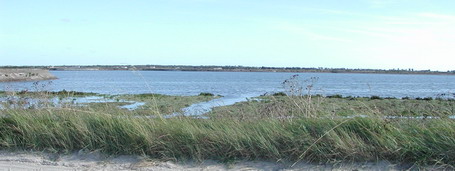
The path led back to the shore. We were the only living creatures in sight. Even the birds had sensibly tucked themselves away in whatever shelter was available. We stood braced against the wind, watching the mad galopade of the boats tugging frantically at their anchors. Then back to the van, back to Ars, back to the hotel, where we counted the hours to the day’s climax—dinner!
St-Martin-de-Ré is the largest and most popular town on the island. In 1625 it was subjected to a long and hungry siege by the English, who thought it a very useful base to have so close to mainland France. Rescued at the last moment by a fleet of French ships—The Alamo with a happy ending—it was extensively re-fortified by the French master of defense Vauban in the latter part of the century.
Having successfully resisted an armed invasion, it has succumbed gracefully to the waves of tourists which inundate it every summer. Approaching through gates now wide open to all comers, we were sign-posted to the old port, a broken circle open to the sea, enclosing a central island umbilically joined to the mainland. Full of bobbing pleasure boats, it is surrounded with shops and restaurants which are picturesque and inviting. A shop-lined street leads inland from the water. Two blocks in and around a corner is an incredibly reasonable hotel which I’d seen recommended in a couple of Europe-on-the-cheap guidebooks, but hadn’t dared to book. We dropped in and had a word with the cordial owner, who showed us a large pleasant double room overlooking the street, with private bath, for 270 francs. It’s called Hotel le Sully. Definitely a bargain; phone/fax numbers are appended. It’s on a busy street next door to a café, so take your earplugs.
Next, a leisurely tour around the shops, containing many charming, even witty souvenirs. (The city fathers should immediately be put in charge of the Phare des Baleines!) One store sells cheerful hand-painted pots, another is devoted entirely to things made out of wood, most of them simple and pleasing. A balancing clown pedals furiously backward and forward on a suspended string, one end of which is raised and lowered by an eccentric wheel geared to an electric motor. There’s a whole cabinet full of rubber stamps which clone well-drawn images of cats and shells and windmills. They come from La Jolla, California! In a bin of kitchen implements Mary finds  the wooden salad servers she’s been looking for ever since we were married—complexly grained rosewood, well proportioned and finished. Another shop has my favorite fisherman’s smocks in loose sturdy cotton, but with buttons up the front. Their generous cut is kind to my own generous proportions. Mary wants to buy me three as an anniversary present, an offer I can’t refuse—there are few garments which fit both my own desire for informal comfort and her distaste for rampant eccentricity. My old T-shirt from Brown University graphically celebrating National Condom Week is not her idea of sartorial elegance.
the wooden salad servers she’s been looking for ever since we were married—complexly grained rosewood, well proportioned and finished. Another shop has my favorite fisherman’s smocks in loose sturdy cotton, but with buttons up the front. Their generous cut is kind to my own generous proportions. Mary wants to buy me three as an anniversary present, an offer I can’t refuse—there are few garments which fit both my own desire for informal comfort and her distaste for rampant eccentricity. My old T-shirt from Brown University graphically celebrating National Condom Week is not her idea of sartorial elegance.
The Église St-Martin is late Gothic and was once fortified. The first thing I noticed was that the entrance to the tower faces the street and is open to the public. A short stone spiral staircase takes you to a first landing where a verger accepts contributions for the privilege of climbing on up to the roof. Along the way, up ancient wooden stairs so narrow and vertiginous that no English Health & Safety officer would admit the public, you pass, first, the clock mechanism in a glass case, and then the three bells which it controls.
The day of our visit was miraculously warm and sunny and the view from the top gave a map-like perspective of the town. It was all so pleasant that I went down to inform Mary that it was worth the effort. On our way back up, the clock struck four-thirty and launched into an extended peal. Squeezing past the other climbers who were waiting for the noise to subside, I went on up to where the bells were conversing. A delicious tintinnabulation! Poe got that word exactly right. I stayed until the first suggestion of discomfort (not nearly so painful as a rock concert) and then retreated.
Every midsummer St-Martin celebrates the Feast of St John. Last year it was held on June 22nd, so we assumed that we had just missed it. Paris had celebrated the summer solstice with mega-loud amplified music until the not-so-early hours; double glazing plus earplugs only reduced it to the ominous thump of an irregular heartbeat. How salubrious it would have been to enjoy a bit of oom-pah from a village band and then retire to unbroken sleep.
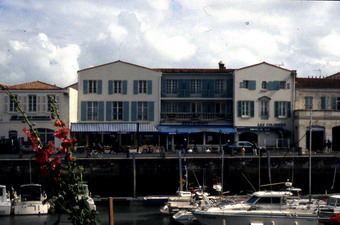
A blessed miracle! In a shop window Mary spots a small poster announcing the Fête de la St-Jean, to take place two days hence on Saturday, June 28th. A bal gratuit is promised, followed by a marching band to round up the citizens and lead them to the town square for feu d’artifice (to the music of Debussy?) and then a bonfire. We could book dinner at Les Colonnes, overlooking the harbor, where we’d just had a decent fish soup lunch, the big copper saucepan left at our table for second helpings—and then follow the band, Pied-Piper-like, to where’er it might take us.
THE next morning the weather was back to its wet and windy norm. On such days the appropriate activities are eating and drinking. Now was the time to visit the Coopérative Vinicole. A brochure I’d picked up said they were open between ten and four-thirty.
According to Rosemary George’s French Country Wines, the Île de Ré’s wine-making tradition goes back to the middle ages. It was apparently well thought of in the late fifteenth century but its reputation subsequently declined. Nevertheless, wine is an important part of the island’s economy. Along with salt, oysters and edible seaweed, grapes are still a principle harvest. The local co-op’s wine was in all the restaurants, market stalls and gift shops. The white vin de pays called Le Royal seemed to be a universal solvent; it appeared automatically on our hotel dinner table along with the carafe d’eau. Its principal virtues were that it was virtually as cheap as the water and also that, after a few days, one could become accustomed to it. The fact that the vines are fertilized with the inedible seaweed, which, according to the green Michelin Tourist Guide, gives it “a hint of algae in the aftertaste”, may tell you more than you wish to know.
Curious to learn what other wines they produced, we set out for the co-op show rooms. The journey took us to the south-eastern part of the island, in which the rapidly expanding villages were taking on an international anonymity. I could have taken photos and passed them off as Hyannis, Palm Beach, or Carmel-by-the-Sea.
The co-op factory/showroom was fronted by a parking lot designed to accommodate a fleet of tour buses. Inside were three long counters for tasting, paying and collecting. The latter two had tails of waiting customers, but the former was empty. A sign on the wall informed me that they were about to close for a two-hour lunch break—a fact which their out-of-date brochure did not include.
Picking up an inventory/price list as I left, I learned that the limited selection consisted only of the wines I had already seen on 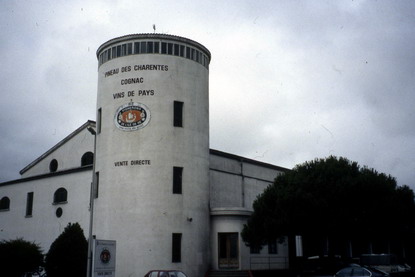 sale elsewhere. I glanced up at the large circular tower which dominated the building. It looked like an enormous barrel resting on one end. Was this perhaps the vat from which all the bottles were filled, together with an appropriate coloring agent? The Île de Ré is part of an area which until recent years could sell whatever it didn’t consume locally to the distillers of cognac and industrial alcohol. Like Languedoc and Gascony, it is now being forced to produce drinkable, even distinctive wines. It’s probably a tough row to hoe: flat sandy soil is not a traditional terroir for great vintages.
sale elsewhere. I glanced up at the large circular tower which dominated the building. It looked like an enormous barrel resting on one end. Was this perhaps the vat from which all the bottles were filled, together with an appropriate coloring agent? The Île de Ré is part of an area which until recent years could sell whatever it didn’t consume locally to the distillers of cognac and industrial alcohol. Like Languedoc and Gascony, it is now being forced to produce drinkable, even distinctive wines. It’s probably a tough row to hoe: flat sandy soil is not a traditional terroir for great vintages.
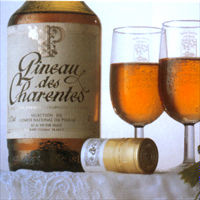
I would later discover that the local aperitif is, to coin a phrase, a different kettle of fish. Officially designated Pineau des Charentes, it is the result of combining no less than year-old cognac with new wine in its first stage of fermentation. They mature together in cask for up to five years. Quality control is certified by a panel which must approve each batch. It is made throughout the cognac region with varying success, but the Pineau produced by the Île de Ré Coopérative is of a high standard. It is not cloyingly sweet and achieves a satisfactory blend of its disparate elements.
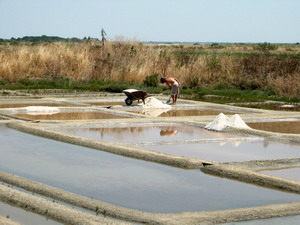 IN the afternoon, a visit to Loix and the “salt museum” maintained by the Coopérative des Sauniers de l’Isle de Ré. Passing up a guided tour in French, I made for the sales room, where salt could be purchased in more forms than I had dreamed of. My attention was immediately grabbed by caramel à la fleur de sel. Could this be anything like the salt-water taffy I’d grown up with on Cape Cod? Indeed it was. Who says nostalgia ain’t what it used to be?
IN the afternoon, a visit to Loix and the “salt museum” maintained by the Coopérative des Sauniers de l’Isle de Ré. Passing up a guided tour in French, I made for the sales room, where salt could be purchased in more forms than I had dreamed of. My attention was immediately grabbed by caramel à la fleur de sel. Could this be anything like the salt-water taffy I’d grown up with on Cape Cod? Indeed it was. Who says nostalgia ain’t what it used to be?
Morton’s Iodized Salt used to claim, “When it rains, it pours”. On the Île de Ré that applies only to the weather. Don’t put their salt into a shaker. It won’t come out because it is hygroscopic (there’s a two-bit word!): no magnesium carbonate has been added. The most refined-looking crystals are fleur de sel, which is skimmed off the top during evaporation and then separately sun-cured. The dirty-looking gray salt contains useful trace elements and is recommended by Larousse for use in the kitchen, reserving the more elegant white product for the table.
What a lot of fuss, you may think—salt is salt. I might have agreed before I cooked with the sea salt we brought home. I found it to have a delicate flavor which made the seasoning of foods more controllable. It’s easy to add just the right amount, so that the mixture neither tastes of salt nor seems to require it.
ON Saturday St John intervened and the sun returned. We were able to put Plan A into operation, which was to visit La Flotte in the afternoon and then come back the short distance to St-Martin for dinner and the fête.
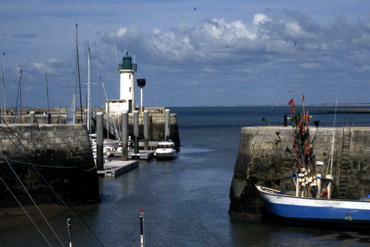
Itself an ancient seaport, genteel La Flotte allows its elder brother to be the center of attention. It is a town to live in rather than merely to visit. Its shops are more useful than frivolous. I was immediately seduced. A vintner was selling his own blanc de blanc straight from a stainless steel vat, decanted on demand into old plastic bottles. At only eight francs a litre I couldn’t resist. The next day I would taste it from the fridge, shudder, and pour it down the drain. As the legendary négociant is said to have explained, “This wine isn’t for drinking—it’s for selling!”
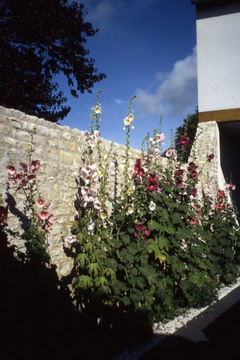 La Flotte feels classically Mediterranean, but with a modest restraint which is not typically Latin. There are many streets of simple well-kept houses which are neither austere nor ostentatious. The usual pattern of white walls, green shutters and orange tile roofs prevails. The only exuberant feature is the thousands of hollyhocks which the whole island supports in such weedy profusion. These flowers seem to do well in sandy seaside soil and a damp climate (though too much rain will wither the leaves). In Provincetown the long footpath behind our house was known as Hollyhock Lane, a name which led my father to restore this striking floral feature.
La Flotte feels classically Mediterranean, but with a modest restraint which is not typically Latin. There are many streets of simple well-kept houses which are neither austere nor ostentatious. The usual pattern of white walls, green shutters and orange tile roofs prevails. The only exuberant feature is the thousands of hollyhocks which the whole island supports in such weedy profusion. These flowers seem to do well in sandy seaside soil and a damp climate (though too much rain will wither the leaves). In Provincetown the long footpath behind our house was known as Hollyhock Lane, a name which led my father to restore this striking floral feature.
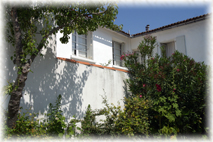
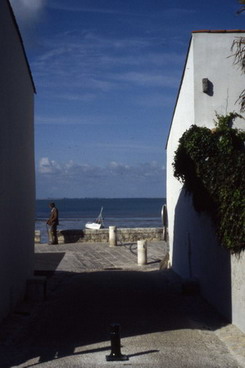
In a little square tucked away amongst the residential streets is Hippocampe, a small hotel which well deserves its “modest comfort” rating in Michelin. Its 18 rooms start at an incredible 102 francs per night, but it is no shabby flea-bag. [Ten years later, the cheapest double rooms are still only 49€.] Rather, it is a modest delightful inn out of a time machine, with an enclosed garden and outdoor breakfast area. The harbor is just a couple of minutes away down a small semi-private path [right]. If we return to the Île de Ré, the first thing I will do is to book it.
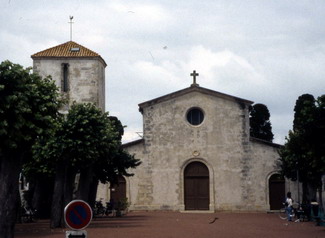
While looking for the hotel I found a gleaming white church, a Gothic jewel box. Unadorned on the outside (as a jewel box should be), its interior reveals both the prosperity and the judicious restraint of its conservators. The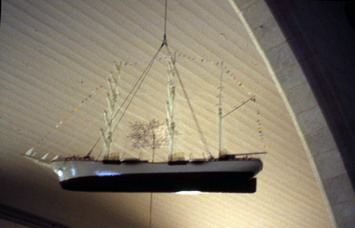 decoration is representative of ebullient Catholic taste, but selectively highlighted at key focal points. In the common practice of votive offerings, there are model ships hanging from the ceiling, but only a few, carefully placed and of superb craftsmanship.
decoration is representative of ebullient Catholic taste, but selectively highlighted at key focal points. In the common practice of votive offerings, there are model ships hanging from the ceiling, but only a few, carefully placed and of superb craftsmanship.
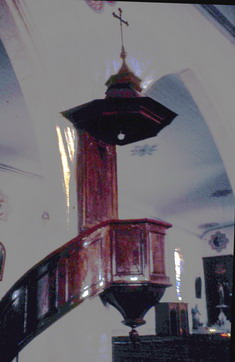 The interior was totally restored in the 1980s. This involved not only repainting, but also the rebuilding of wooden structures which had partially rotted away, and even the construction of totally new features that are so compatible with the old as not to be immediately obvious. The repainting is also remarkable: it includes trompe l’oeil columns and draperies which are deceptive precisely because they are comparatively simple and therefore plausible. The ancient
The interior was totally restored in the 1980s. This involved not only repainting, but also the rebuilding of wooden structures which had partially rotted away, and even the construction of totally new features that are so compatible with the old as not to be immediately obvious. The repainting is also remarkable: it includes trompe l’oeil columns and draperies which are deceptive precisely because they are comparatively simple and therefore plausible. The ancient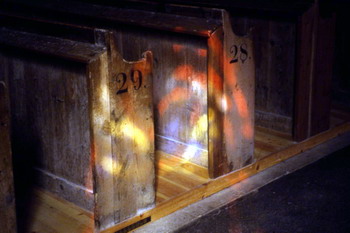 wooden pews were splashed with color from sun through stained glass. We stayed longer than in any other church on the island.
wooden pews were splashed with color from sun through stained glass. We stayed longer than in any other church on the island.
Do I sound like the La Flotte Chamber of Commerce? So be it. In my present mood I could happily live and die there.
BACK in St-Martin, the maitre de at Les Colonnes had obligingly saved us a window table overlooking the harbor. The food was neither good nor bad enough to be very interesting, but the prospect was pleasing and the open window wafted away the cigarette smoke. By the time we had paid the bill, it was growing dark.
The sound of a marching band informed us that the fête was underway. They came into view, dressed in white trousers, blue jackets and yaughtsman’s caps, just like the uniform I wore in the Provincetown marching band at the age of twelve. There, in fact, was a young lad looking very much like a picture Dad took of me over half-a-century ago. My eyes did not remain dry.
The musicians were accompanied by a swelling crowd of townspeople plus a few tourists, with dozens of small children bearing simple Chinese lanterns hanging from sticks and made of accordion-pleated paper in pastel colors with small votive candles in tin cups resting on their cardboard bottoms. No Eureaucrat would have given his approval, but there were no mishaps.
The band played a repetitive fanfare as it snaked through the streets, finally arriving at the Place de la Republique for the concluding ceremonies. A big bonfire, maybe twelve feet high, awaited ignition. But first there were the fireworks, not awesome by Hollywood standards but, within the context of the occasion, on just the right scale. We were close by and could observe them in detail: it was more chamber music than grand opera.
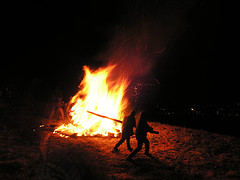
Finally, the bonfire (which God in his infinite mercy had refrained from soaking with a day’s hard rain) was dowsed with petroleum and set alight. We all drew closer and then gradually fell back as the flames rose and the heat spread out. A handful of kids on the edge of the square carried on with their own little fireworks display but nobody, including the gendarmes, seemed worried. The square floated somewhere in time and space, absorbed in a universal small-town ritual: Norman Rockwell with a French accent. We drifted back to the van, which we’d parked just a block away beside the church, and inched slowly out of town through the happy dispersing crowds.
THE next morning the rain was bucketing down with renewed vigor and the puddles around our little studio had become a moat. There were three days left of our holiday, but to what purpose? Risking a penalty for early departure, we gave notice for the following morning and immediately felt more cheerful. After all, it was only money; our time was once more our own! We paddled back to the Ars market and stocked up on salami, cheese, radishes, another Tortoise Cake and various things that would help us remember the good moments.
This was the place of which so many had said, “The Île de Ré! You lucky people! You’ll love it!” But most of them have friends or family living there, to fold them into the community. I thought of my return visits to Provincetown over the years, sometimes in the dead of winter, when the lonely tourist would have fled in consternation. But there are friends waiting for me who make the weather a matter of small importance. Gazing outward from a room warmed by a log fire, a hot drink and cordial companionship is not like shivering on the street, staring in at another’s pleasure. If Mary and I return to the Île de Ré I hope that next time God, at least, will make us welcome.
Le Parasol, rte St-Clément-des-Baleines, 17590 Ars-en-Ré 05 46 29 46 17 F 05 46 29 05 09
Hippocampe, 17630 La Flotte 05 46 09 60 68
Hotel le Scully, 17410 St-Martin-de-Ré 02 46 09 26 94 F 02 46 09 06 85
How pathetic! A sniveling, ungrateful report. An American composer wrote us up last year; he was much more sympatique. The Île de Ré is My modest holiday home; if I want occ asional relief from the eternal effulgence of My official Vatican residence, that’s My affair. In fact, on their way back to London Mary and John were very lucky in Normandy, where I granted them beautiful scenery, sunny weather, and two extra nights in one of my favorite châteaux. I even allowed them three meals at Au Caneton in Orbec, where last October one of my personally blessed chefs had served John and his long-suffering companion Frank a wonderful duck on their last night in France. But you’ll never hear this side of the story from your pompous narrator. He’d rather play for sympathy.
asional relief from the eternal effulgence of My official Vatican residence, that’s My affair. In fact, on their way back to London Mary and John were very lucky in Normandy, where I granted them beautiful scenery, sunny weather, and two extra nights in one of my favorite châteaux. I even allowed them three meals at Au Caneton in Orbec, where last October one of my personally blessed chefs had served John and his long-suffering companion Frank a wonderful duck on their last night in France. But you’ll never hear this side of the story from your pompous narrator. He’d rather play for sympathy.
What a load of papal bull! [author]
©1997 John Whiting